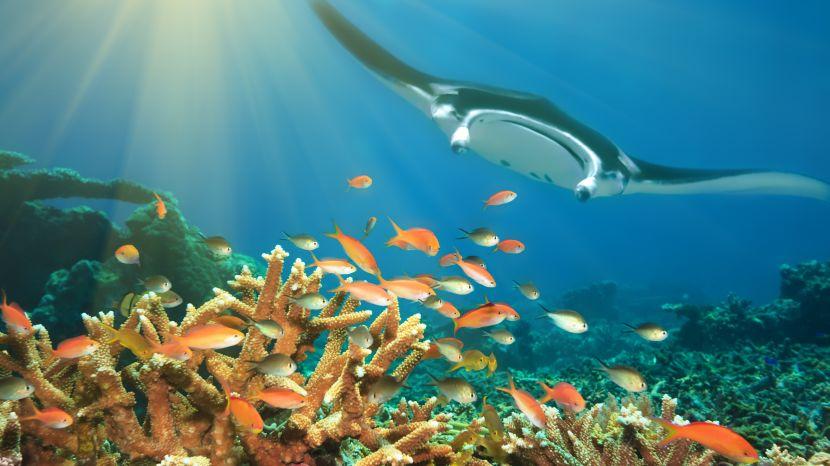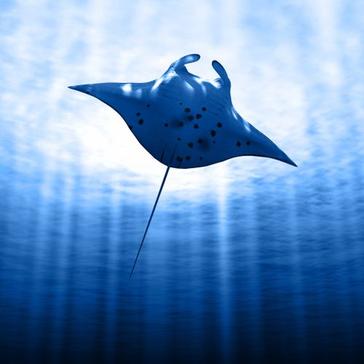What do we know about life under the sea? Well…not very much. It is a fact that we know more about outer space than we do our own oceans, and one of the most mysterious creatures of all is to who we’ll be lending our focus for today’s blog. Below, we’ll be giving you some fascinating facts about manta rays, their history, and some quick-fire trivia that’s bound to impress any marine-life lover.
Background – what do we know about rays and their history?
While there are up to 11 species of ray, these species are split further into what we call ‘genera.’ These two genera consist of ‘Mobula’ and ‘Manta’ rays. Having only being separated into these two larger categories in 2009, it is actually believed that a third species of ray resides somewhere in the Atlantic.
So, where did they come from?
The fact is, nobody is exactly sure. Studies show that today’s rays tend to live in warm, tropical waters such as the Indo-Pacific Ocean, around Australia, and the East Coast of Africa. A particularly popular habitat for manta rays is the Maldives, with its beautiful clear waters and plentiful plankton for the rays to feed on. As far as we know, however, manta rays as we know them are believed to have first appeared on earth some 5 million years ago, according to data given by scientists when discovering fossils.
Some quick fire facts about manta rays..
- The word ‘Manta’ comes from the Spanish for ‘cloak’ or ‘shawl’, and in the Maldivian language, mantas are known as ‘En Madi’, which in English means ‘small fish eating ray’.
- Typically living until around the age of 25 years old, there have been reports of manta rays living well into their 40’s, with some people believing these aquatic angels can live until the age of 100.
- Whilst we are mentioning angels – did you know that mantas have a cousin known as the ‘devil ray’?! Coining their name from the shape of their heads, devil rays have had a hard time throughout history with some people sadly mistaking these peaceful creatures for a bad omen.
- Like many of their other aquatic counterparts, rays don’t breathe air. Instead, they use their gills to respire under water, and must keep moving at all times to keep water flowing over their bodies. This means no time for sleep or rest, making manta rays one of the most active species on earth!

Below, we'll outline just a little more about manta biology and their temperament...
Brain boxes: As far as fish go, Manta and Mobula rays are particularly smart creatures, displaying intelligent behaviours such as coordinated and cooperative feeding. Their large brains give them an edge over around 32,000 of their underwater friends.
Deep sea divers: Speaking of brains, it is important that rays keep active and warm, as to keep things ticking over. Giant mantas, for example, have an amazing counter-current heat exchange system going on within their veins and arteries, allowing them to have a more stable, warm blood flow and are therefore able to be fantastic deep-divers.
Flirty friends: While they are mostly solitary creatures, mantas won’t pick a fight with you - they are completely harmless to humans (unlike their cousin, the sting ray.) While they do have teeth (300 rows of them, to be exact!) these are are mostly hidden and, as such, are not used since manta prefer to filter-feed. In fact, the only use that rays may have for their teeth is when courting– scientists believe that by flashing their pearly (or rather, gummy) whites, rays may find more success when attempting to find a mate.
Good time guys: Although scientists don't exactly know the reason why, manta ray have been frequently spotted jumping out of the sea. This could be to escape a potential predator, to impress a mate, to shake off parasites...or, simply put, because they just like doing it. Is there any greater joy than splashing about in the sea, underneath the glistening sun?
Mystery manta: Despite all of the above, very little is known about manta rays, from their biology to their history on this earth. At the very least, we can all agree that the beauty of mantas is something to behold, and their serene nature is a fantastic part of the aquatic world. And it's with this that we want to protect and preserve their place on our planet.

To round off today's post, we're going to give you a little more information about manta ray conservation. While the best way to get involved would be to take part in one of our projects, there are a number of other ways in which we can all be kinder to the sea and all of its inhabitants:
Tour responsibly: While we encourage getting to know these beautiful beasts of the watery world, the methods in which you do so will always matter. Choose a sustainable source of tourism, one with a clear code of conduct and that in no way will chase, harass or harm mantas or their habitats. The Great Projects have you covered, teaming you up with recognised PADI trainers and researchers who'll allow you to monitor manta ray, photo-IDing them and measuring them up to have their statistics inputted to the identification database.
Choose safe, sustainable products: Recently, a lot of light has been shed on the use of plastics in makeup and toiletries - particularly in face or body scrubs, there are tiny beads make of plastic, which rinse down our drains and straight into the ocean. The animals in the ocean often mistake these microbeads as fish eggs, plankton or other types of food, so as we contaminate waters with dangerous products, the toxicity of the plastic is killing these poor creatures in their own homes. Take care to select products that don't contain these harmful elements, and do your bit to keep our oceans clean.
Volunteer, donate, and aid research into sustainability: As above, The Great Projects can get you set up on some amazing tours - meet manta rays, swim with sharks or snorkel with turtles - the choice is yours. A number of proceeds from each and every trip go towards further conservation for the animals involved, as well as providing sustainable tourism for everybody to enjoy. Donations are widely accepted in many areas, so don't be afraid to dive into charity and help to keep the legacy of these animals alive.















